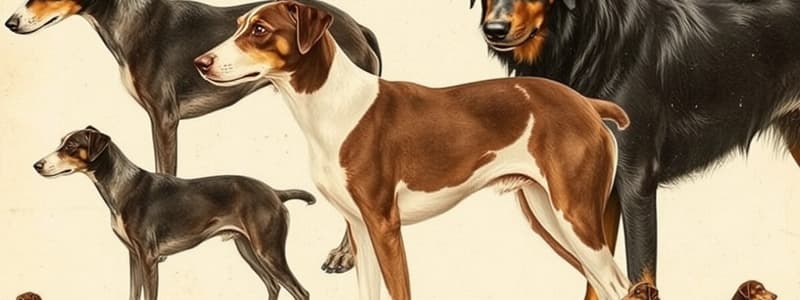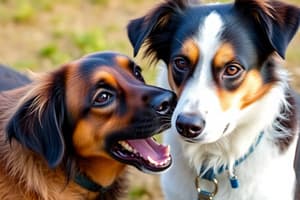Podcast
Questions and Answers
What is a group created by the American Kennel Club (AKC) for dogs with a natural instinct to herd livestock called?
What is a group created by the American Kennel Club (AKC) for dogs with a natural instinct to herd livestock called?
- Working dogs
- Sporting dogs
- Herding dogs (correct)
- Terriers
What year was the herding dogs group created by the AKC?
What year was the herding dogs group created by the AKC?
1983
Which of the following breeds is recognized under the herding dogs group? (Select all that apply)
Which of the following breeds is recognized under the herding dogs group? (Select all that apply)
- Border Collie (correct)
- Beagle
- Australian Cattle Dog (correct)
- German Shepherd (correct)
What unique pattern do many Australian Cattle Dogs have?
What unique pattern do many Australian Cattle Dogs have?
Where did the Australian Shepherd originate?
Where did the Australian Shepherd originate?
The Border Collie has a docked tail based on AKC standards.
The Border Collie has a docked tail based on AKC standards.
What is the size range of the German Shepherd?
What is the size range of the German Shepherd?
What type of coat does the Old English Sheepdog have?
What type of coat does the Old English Sheepdog have?
What do Pembroke Welsh Corgis have that aids their herding capabilities?
What do Pembroke Welsh Corgis have that aids their herding capabilities?
Shelties are considered miniature collies.
Shelties are considered miniature collies.
Flashcards
Herding Dogs
Herding Dogs
Dogs with a natural instinct to herd livestock; newest AKC grouping (1983). Examples: Border Collie, German Shepherd.
Australian Cattle Dog
Australian Cattle Dog
From Australia, these dogs herd cattle and have unique speckled patterns from Dalmatian cross-breeding.
Australian Shepherd
Australian Shepherd
Breed from the western US used for herding various livestock; medium-long coat, docked tail.
Border Collie
Border Collie
Signup and view all the flashcards
Collie
Collie
Signup and view all the flashcards
German Shepherd
German Shepherd
Signup and view all the flashcards
Old English Sheepdog
Old English Sheepdog
Signup and view all the flashcards
Pembroke Welsh Corgi
Pembroke Welsh Corgi
Signup and view all the flashcards
Shetland Sheepdog
Shetland Sheepdog
Signup and view all the flashcards
Sheltie vs. Collie Head Shape
Sheltie vs. Collie Head Shape
Signup and view all the flashcards
Study Notes
Herding Dogs Overview
- Herding dogs, recognized by the AKC in 1983, possess a natural instinct to herd livestock such as sheep, cattle, and ducks.
- Characterized by high energy levels, these breeds represent the newest grouping in the AKC classification system.
- Breeds in this group include: Australian Cattle Dog, Australian Shepherd, Border Collie, Collie, German Shepherd Dog, Old English Sheepdog, Pembroke Welsh Corgi, and Shetland Sheepdog.
Australian Cattle Dog
- Known as blue/red heelers; they originate from Australia and primarily herd cattle.
- Unique speckled patterns result from cross-breeding with Dalmatians.
- AKC recognized colors: blue, blue mottled, blue speckled, red mottled, red speckled.
- Recognized markings: black and tan, red, tan.
Australian Shepherd
- Despite its name, this breed originated in the western United States.
- Features a medium-long thick coat and often has a docked or naturally bobbed tail.
- Frequently used in farm settings for herding various livestock, including horses and ducks.
- AKC recognized colors: black, blue merle, red, red merle.
- Recognized markings: tan points, white, white marking and tan points.
Border Collie
- Originated on the Scotland-England border; known for high intelligence and energy.
- Renowned for strong herding instincts, considered one of the best herding breeds for cattle and sheep.
- AKC standards specify that they do not have a docked tail.
- AKC recognized colors: 17 variations.
- Recognized markings: 7 different patterns.
Collie
- Hails from Scotland and Northern England; medium-sized breed weighing 50-70 lbs.
- Traditionally worked as herders for cattle and sheep.
- AKC recognized colors: 10 variations.
- Recognized markings include black and tan, blue merle, sable, and sable merle.
German Shepherd
- Originated in Germany as a sheep herder; large breed weighing between 50-90 lbs.
- Medium energy levels; popular in police work, search-and-rescue, military, and service roles.
- AKC recognized colors: 11 variations.
- No specific markings recognized by the AKC.
Old English Sheepdog
- Developed in England; large breed weighing 60-100 lbs with a medium energy level.
- Historically assisted farmers in driving cattle and sheep to market.
- Distinctive long, shaggy coat.
- AKC recognized colors: blue and white, blue grey & white, blue merle & white, grey and white, grizzle & white.
- No specific markings recognized.
Pembroke Welsh Corgi
- Originated in Wales, descending from Viking dogs; medium-sized and weighing 25-30 lbs.
- Used for herding cattle and sheep, characterized by a long body and short legs.
- Erect ears provided an advantage in herding tasks.
- AKC recognized colors: black and tan, fawn, red, sable.
- Recognized markings: white.
Shetland Sheepdog
- Originated in the Shetland Islands, primarily herding sheep.
- Medium-sized, weighing around 30 lbs; likely descended from Scottish Collie and King Charles Spaniel.
- AKC recognized colors: black & white, black white & tan, blue merle & white, blue merle white & tan, sable & white, sable merle & white.
- No specific markings recognized.
Sheltie vs. Collie
- Shetland Sheepdogs (Shelties) are distinct breeds and not miniature versions of Collies.
- Differentiated by head shape; Shelties have a slight elevation at the forehead, unlike Collies.
Studying That Suits You
Use AI to generate personalized quizzes and flashcards to suit your learning preferences.


